Campania, located to the north of Calabria and Basilicata, is the second most populated region of Italy and stretches along the Tyrrhenian Sea. It prides itself on its impressive coastline, picturesque cliff-side towns and gorgeous islands. So, it shouldn’t be any surprise that there are many remarkable castles throughout the region.
We’ve already shared our favorite castles in Calabria, Sicily, and Puglia so now let’s head on over to Campania and look at our five favorite castles that can be found in this beautiful southern region:
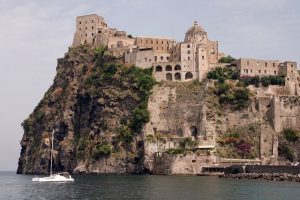
Aragonese Castle (Ishcia)
This castle sits on the volcanic island of Ischia in the Gulf of Naples. It is believed that the castle was built by the tyrant of Syracuse Hiero I in 474 BC. This centuries-old castle was once made of of two watch towers that were used to guard against enemy attacks. However, this could not prevent it from changing hands over the course of the years from the French to the English and the Bourbons. In the middle ages, the Aragona family took over and gave it the name that it still holds today. In 1441, a stone bridge was built connecting the castle to the land. You can still walk this bridge today! Throughout it’s long history the castle has been used for many purpose including a residence and even a prison between 1806 and 1815. You certainly can’t miss this iconic castle when visiting Ischia.
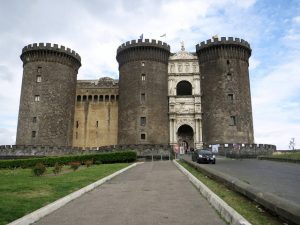
Castel Nuovo (Naples)
Castel Nuovo, also known as Maschio Angioino is located in the center of Naples. This “new castle on the block” was built in 1279 when King Charles I of Naples ordered its construction. Why did he chose Naples? Well, the capital of the Kingdom of Naples was Palermo and was later moved to Naples. Unfortunately, Charles I would never live in the castle he commissioned, instead it was his successor Charles the II that would be the first to move in. He was later succeeded by his son Robert who had the Palatina Chapel added to the castle. In 1442 the Aragonese dynasty came in under the reign of Alfonso V who fortified the castle. Then, in 1470 the white marble triumphal arch was built to commemorate Alfonso V. Today the castle hosts cultural events and is home to the Municipal Museum which exhibits sculptures, paintings and frescoes from the 14th to 19th century.
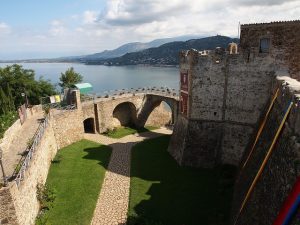
Castello Aragonese (Agropoli)
The influence of the Aragona dynasty can be seen once again, this time in the old town of Agropoli in Salerno not far from the Ancient Greek city of Paestum. Like may of the Aragonese castles, it was built to be a fortress and watch tower. Overlooking the sea, you would think its high walls sloping down the tall cliffs would be enough to keep the invaders away but a deep moat, part of which can still be seen today, was also built around the castle for extra protection. The castle has a triangular shape and is made up of three round towers and a courtyard, which in present day acts as a public garden and outdoor theatre. Agropoli began to expand outside of the medieval walls that enclose the old town but even after all these years the old town has remained in good condition and most of the defensive walls, as well as the 7th century gateway into the old town, are still intact.
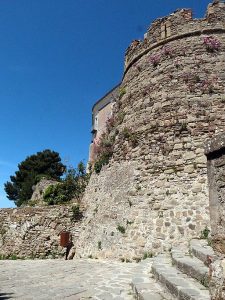
Castello dell’Abate (Castellabate)
Castellabate is a charming hilltop town in the province of Salerno. This medieval village was built up around the castle that was constructed in 1123 to protect the population from Saracen attacks. The walls surrounding the castle are linked together by four towers and below is a subterranean that was built as an escape route in case of invasion. The castle as well as its underground escape tunnel is open to the public. Definitely take the time to get lost in the alleyways and narrow streets of the hamlet. Before you visit, you should watch the 2010 Italian comedy Benvenuti al Sud, which was filmed here. You’ll see why it has become a popular place to visit.
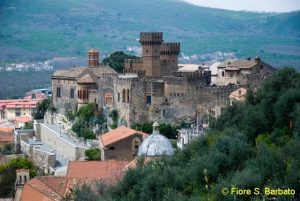
Castello Lancellotti (Lauro)
The Castello Lancellotti in the small town of Lauro in the Province of Avellino looks like something out of a fairy-tale. Built in the early 11th century this castle sits on a hilltop and is one of the most beautiful noble residences in Campania. It has been home to many aristocratic families, right up to its most recent owners, the Lancellotti family, in 1632, who still own it today. In 1799, it was destroyed by a terrible fire started by French troops and was later rebuilt in 1872 by Filippo Lancellotti. In fact, some of the architecture in the “new” castle is certainly influenced by that period. As you make your way through the castle surrounded by its rich and intricate Gothic, Renaissance, and Baroque design elements, you can’t help but feel like royalty. The courtyards are beautifully decorated with plants, flowers and fountains and the terraces offer an incredibly beautiful view that you won’t want to leave. Ladies, whatever you do, don’t forget your glass slippers, you never know!
Image Credits: Jimmy Harris, Graham C99, Paul Barker Hemings, Ziegler175, Fiore Silvestro Barbato








